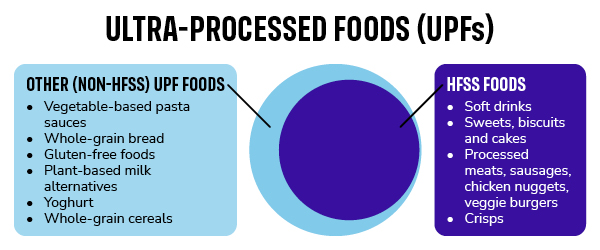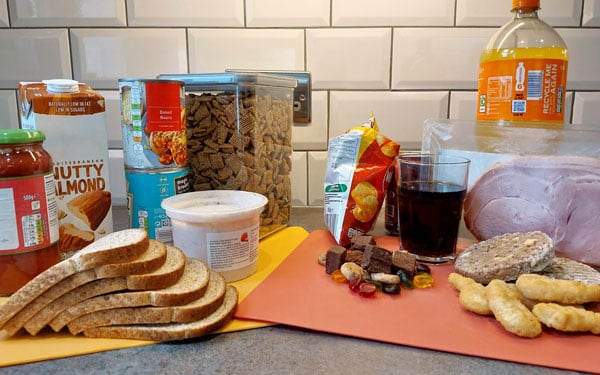 Kendra Chow is Policy and Public Affairs Manager at World Cancer Research Fund and a registered dietitian.
Kendra Chow is Policy and Public Affairs Manager at World Cancer Research Fund and a registered dietitian.
News is written in a way to grab our attention, and share information in black-and-white terms: something is either good or bad, all or nothing, guilty or not guilty. But nutritional science isn’t always that clear cut. So, if the evidence doesn’t yet show whether UPFs are good or bad for us in black-or-white terms, how can we navigate the grey area between what’s in the headlines and what we put on our plates?
What are ultra-processed foods?
Food can go through various degrees of processing. This can include minimal processes like chopping and boiling, all the way up to commercial and industrial processes. The NOVA system of food classification is the most widely used for categorising how food is processed. There are 4 categories under NOVA:
- unprocessed and minimally processed
- processed culinary ingredients
- processed
- ultra-processed foods
(read more about the types of foods in each category).
What’s important to know is that the NOVA system is designed to classify foods based on degree of processing, and not nutritional quality. These types of systems are not universally accepted, and NOVA in particular has been criticised for being too broad across and within categories.
For example, foods that are high in fat, sugar and salt (HFSS) are typically categorised as UPFs. These foods are energy dense (eg high in calories) and low in nutrition quality. We know for certain that a diet high in these foods is detrimental to health and can lead to the development of chronic diseases, including cancer.
However, also in the UPF category are foods such as:
- vegetable-based pasta sauces
- sliced wholemeal bread
- low-sugar wholegrain cereals
- and fruit yogurts.
These foods do offer nutritional value, as they contain fibre, as well as macro- and micro-nutrients. Foods that are needed for medical or nutritional purposes are also in this category, such as gluten-free foods or fortified plant-based milk alternatives (eg soy, oat).
If we were to look at a Venn diagram of UPFs and HFSS foods, HFSS foods would certainly eclipse and contain the majority of UPF foods that we know are unhealthy and should be avoided.
However, there are some foods outside of this sphere that are also categorised as UPFs, but can contribute to a healthy, well-balanced, nutrient-rich diet. These foods are often more affordable and easier to prepare quickly, for those of us who have limited resources and/or time.

Should we avoid UPFs all together?
Nutritional studies often look at the intake of UPFs as a broad category, and have yet to identify precisely why UPF consumption may lead to the development of chronic diseases.
Research has not yet been able to distinguish whether high UPF consumption is harmful because it results in dietary patterns that are typically high in fat, salt and sugar, or whether processing itself or specific ingredients added through commercial processing (like emulsifiers or additives) may contribute as well.
It’s important to remember that such ingredients are added for a purpose – they can improve texture and palatability, protect us from harmful bacteria in our food, and extend the shelf-life of products and reduce food waste.
Studies have yet to determine whether disease risk outcomes are also affected by other factors such as smoking, inactivity, deprivation and other social determinants of health (such as education and income).
The good news: science is always working to get better. Studies have indicated that processing may influence health outcomes, which is why it is worth exploring how and why food processing is may be cause for concern.
Ongoing research is trying to answer these very questions, including a large study from Imperial College London investigating how UPFs influence cancer risk in the European population and a study from the International Agency for Research on Cancer (IARC) looking at food variety, different food types, including UPFs and cancer risk.
We do know that we should avoid UPFs that are high in fat, sugar or salt (HFSS); this is reflected in most dietary guidelines worldwide, including our own Cancer Prevention Recommendations, and reducing HFSS intake is the objective of many best-practice health policies (such as the Soft Drinks Industry Levy in the UK). However, until we know answers to these outlying questions, there isn’t enough concrete evidence to know for certain whether non-HFSS UPFs should also be avoided.
We need to continue to investigate the impact UPFs may have on our health, and advance widespread implementation of policies to improve our food environments that increasingly promote UPF consumption.
Food and media: consume both mindfully
So, if there’s not sufficient evidence yet, what’s with all the fearmongering UPF headlines lately? Sadly, there are many elements that contribute to and pollute the places where we get our news and health-information.
Alarming headlines are attention grabbing, and fuel clicks and shares, which in turn promote brand recognition and ad revenue. Many social elements also come into play that determine the level of attention and coverage that the media gives to a story, and how it permeates and moves through our social spheres and conversations.
It is particularly interesting to consider the contrast between the recent experiments conducted by Dr Chris van Tulleken and registered dietitian Jessica Wilson, who both ate an 80% UPF diet for a month. Both reported vastly different experiences, and while the findings by each individual can’t be applied to entire populations anyway, they indicate that more research may also be required into any ethnic or gender differences (as well as socioeconomic ones) when it comes to how UPFs are processed by the human body.
Media, including its personalities, can shape and have a large influence on our perception of what is healthy and what isn’t. Just as when you’re choosing what food to eat, it’s also very important to consider the types and quality of media and information you consume.
When it comes to UPFs, it is best to skip the sensationalism and opt for facts over fear. Avoid foods high in fat, salt and sugar, and choose options that are nutrient-rich such as wholegrains, vegetables and fruits.
This can include foods that may have had some degree of processing, such as frozen or canned vegetables, fruit or pulses, or commercially made breads and yogurts that are low in sugar and salt.
Against the backdrop of the current cost-of-living crisis in many countries and rising rates of food insecurity, it is not responsible to stigmatise a broad category of foods that also includes lower-cost, accessible food options that can aid the preparation of home-cooked, nutritious meals.
Individuals and families don’t need to include a side dish of guilt or shame when serving up their meals to eat. This is not equitable. Facts over fear: let’s collectively serve up and consume healthier options for ourselves.
This post was edited slightly on Thu 5 October for ease of reading.


